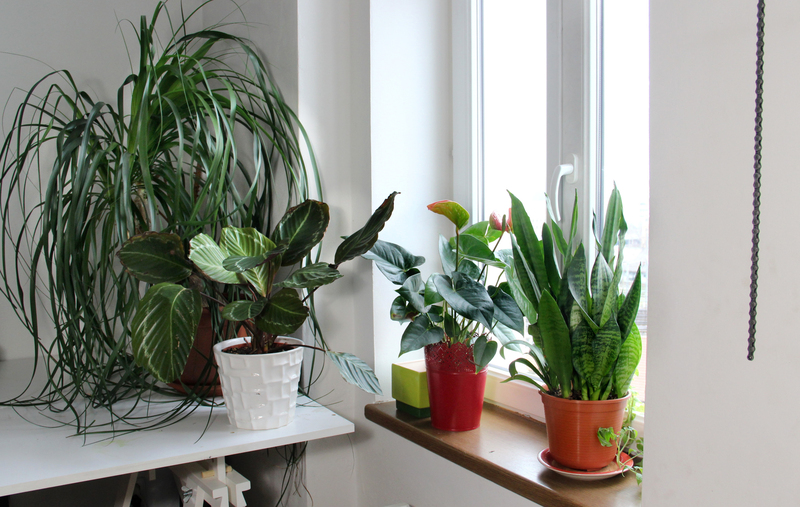From Seed to Table: Herb Gardening
Posted on 19/08/2025
From Seed to Table: The Ultimate Guide to Herb Gardening
Cultivating fresh herbs at home is a transformative journey, elevating your cooking and connecting you to the natural world. Whether you're a beginner or an experienced green thumb, herb gardening from seed to table presents endless opportunities for flavor, health, and sustainability. In this comprehensive article, we'll uncover everything you need to know about herb growing--from selecting seeds to harvesting and enjoying your aromatic harvest at the table.

Why Grow Herbs From Seed?
Starting your herbs from seed unlocks numerous advantages:
- Wider Selection: Seeds offer more variety compared to store-bought plants.
- Cost-Effective: Growing from seeds is significantly cheaper than buying mature plants.
- Healthier Plants: You control soil, conditions, and avoid pesticides.
- Personal Satisfaction: There's a deep sense of accomplishment in nurturing herbs from sprout to harvest.
Getting Started: Choosing the Right Herbs for Your Garden
The first step in your seed-to-table herb journey is selecting the right herbs. Consider your cooking preferences, climate, and available space. Popular and beginner-friendly options include:
- Basil: Perfect for Italian and Thai dishes, basil thrives in warm, sunny spots.
- Parsley: This versatile garnish is a staple in many international cuisines.
- Mint: Refreshing in drinks and desserts, but best kept in containers as it spreads rapidly.
- Cilantro: Essential for Mexican, Indian, and Asian dishes.
- Chives: Mild onion flavor, ideal for salads and soups.
- Rosemary: Hardy and aromatic, perfect for roasting meats and vegetables.
- Oregano & Thyme: Mediterranean essentials with robust flavors.
Consider Your Growing Conditions
Evaluate your available light, space, and whether you'll grow herbs indoors or outdoors. Most culinary herbs prefer at least 6 hours of sunlight per day and well-draining soil.
Step-by-Step: How to Start Herb Seeds
1. Gather Supplies
- High-quality herb seeds
- Seed starting trays or small pots
- Seed-starting mix (lightweight and sterile)
- Spray bottle for gentle watering
- Labels and markers
- Plastic dome or clear plastic wrap (for humidity)
2. Prepare Your Seed Trays
Fill containers with moist seed-starting mix, pressing lightly to remove air pockets. Herbs like basil, oregano, and parsley each have different light and temperature requirements, so check the seed packet for specific guidelines.
3. Sow the Seeds
- Sow seeds at the depth indicated on the packet--usually just below the surface.
- Gently mist the soil to settle seeds in place.
- Label each container for easy identification.
4. Maintain Optimal Conditions
- Use a heat mat or warm, sunny windowsill to ensure temperatures around 65-75?F (18-24?C).
- Cover with a plastic dome to retain humidity until seedlings emerge, then remove cover for airflow.
- Keep soil consistently moist, but not soggy--aim for damp sponge consistency.
5. Transplanting Seedlings
Once your herb seedlings develop their second set of leaves (true leaves), they're ready to move to larger pots or the garden. Harden seedlings by gradually exposing them to outdoor conditions over a week.
Essential Care for Thriving Herb Plants
Soil & Fertilizer
- Plant herbs in well-draining soil. If using containers, choose pots with drainage holes.
- Mix in some organic compost before transplanting.
- Fertilize sparingly; over-fertilizing can reduce essential oil concentration and flavor.
Watering Practices
- Water consistently, keeping soil moist but not waterlogged.
- Container herbs often need more frequent watering than those in garden beds.
- Water at the base of the plant to avoid mildew on leaves.
Sunlight & Temperature
- Most culinary herbs require full sun; some like mint and parsley can tolerate partial shade.
- Watch for yellowing leaves, which can signal too much sun or overwatering.
Pest & Disease Control
Herbs are generally resistant to pests, but aphids, spider mites, and powdery mildew can appear. Use organic treatments like neem oil or insecticidal soap as needed.
Pruning and Pinching for Better Growth
- Pinch off flower buds to encourage leaf production and prolong harvest.
- Regular harvesting promotes bushier growth and prevents herbs from becoming leggy.
Harvesting Herbs: Timing and Techniques
One of the joys of herb gardening is harvesting fresh leaves and adding them directly to your meal. Follow these best practices:
- Harvest in the morning after dew has dried but before the sun is too hot.
- Use clean, sharp scissors or garden shears.
- Pick only up to a third of the plant at a time to allow regrowth.
- Basil, mint, and cilantro can be cut above a pair of leaves for rapid regrowth.
- Shrubby herbs like rosemary and thyme can withstand more aggressive snipping.
Preserving Your Herb Harvest
When you have more herbs than you can use fresh, preserve the extra for later:
- Drying: Bundle and hang upside down in a cool, dry spot or use a dehydrator.
- Freezing: Chop and freeze in olive oil or water using ice cube trays for easy portioning.
- Infused Oils & Vinegars: Add fresh herbs to bottles of oil or vinegar for flavor-packed condiments.
From Garden to Table: Cooking with Fresh Herbs
There's nothing like the flavor burst that fresh herbs bring to homemade dishes. Here are some culinary ideas for using your garden-fresh herbs in everyday cooking:
- Salads & Dressings: Toss chopped chives, dill, or parsley for a refreshing kick.
- Marinades and Sauces: Blend basil into pesto or oregano into a tomato sauce for depth of flavor.
- Herb Butter: Mix soft butter with thyme, sage, and rosemary for a savory spread.
- Herbal Teas: Steep mint, lemon balm, or chamomile for soothing beverages.
- Garnishes: Cilantro, basil, or parsley add color and freshness to any plate.
For best results, add soft-leaf herbs like basil and cilantro at the end of cooking, while hardy herbs like thyme or rosemary can be added earlier.
Common Questions About Herb Gardening from Seed
How long do herbs take to grow from seed?
Germination times vary, but most herbs sprout within 5-21 days. Leafy harvesting can often begin in 4-8 weeks, depending on the variety.
Can I grow herbs indoors year-round?
Absolutely! Indoor herb gardens thrive on sunny windowsills or under grow lights, providing fresh ingredients in any season.
Which herbs are easiest for beginners?
Basil, chives, parsley, and mint are all forgiving and fast-growing, making them great starter herbs for new gardeners.
How do I prevent herbs from bolting?
Bolting, or premature flowering, often happens in hot weather. Harvest regularly and provide shade during peak summer to prolong vegetative growth.
Herb Gardening for Every Space: Containers, Raised Beds, and Windowsills
A major advantage of herb gardening is versatility. Whether you have a sprawling backyard or just a sunny apartment window, you can enjoy fresh herbs.
Container Gardening
- Choose pots at least 6 inches deep with good drainage.
- Group herbs with similar water and light requirements.
- Ideal for urban spaces, balconies, or patios.
Raised Bed Gardens
- Excellent for larger harvests and improved drainage.
- Combine several herb varieties in one bed for a stunning kitchen garden.
Indoor Herb Gardens
- Grow herbs year-round, even in apartments.
- Rotate pots for even light exposure.
- Use grow lights for consistent results in low-light conditions.

Sustainable Practices for Herb Gardeners
Cultivating a sustainable herb garden is both rewarding and environmentally friendly. Implement these tips for eco-friendly gardening:
- Use recycled containers and rainwater for watering.
- Make your own compost for a chemical-free fertilizer.
- Rotate crops and companion plant to deter pests naturally.
- Attract pollinators by planting flowering herbs such as chives and basil.
- Minimize pesticide use and encourage beneficial insects like ladybugs.
Conclusion: From Seed to Table--A Delicious Journey
Growing herbs from seed to table is a rewarding adventure that enhances your culinary creations and your connection to nature. With simple supplies and a bit of care, you can turn even the smallest space into a thriving kitchen herb garden. From sowing seeds and nurturing plants to harvesting vibrant, aromatic leaves, every step brings you closer to fresh, flavorful meals.
Start your own herb gardening journey today, savoring the freshest ingredients and the satisfaction of homegrown goodness straight from your garden to your table. Happy planting!

